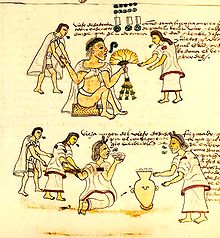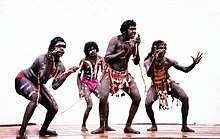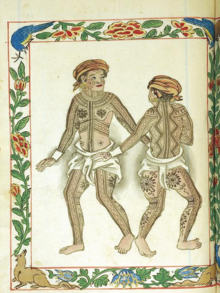Loincloth
|
Read other articles:

2021 MMA event UFC on ESPN: Cannonier vs. GastelumThe poster for UFC on ESPN: Cannonier vs. GastelumInformationPromotionUltimate Fighting ChampionshipDateAugust 21, 2021 (2021-08-21)VenueUFC ApexCityEnterprise, Nevada, United StatesAttendanceNot announced[1]Event chronology UFC 265: Lewis vs. Gane UFC on ESPN: Cannonier vs. Gastelum UFC on ESPN: Barboza vs. Chikadze UFC on ESPN: Cannonier vs. Gastelum (also known as UFC on ESPN 29 and UFC Vegas 34) was a mixed martial arts…

Czech indie pop band Lake MalawiLake Malawi performing in 2019Background informationOriginTřinec, Czech RepublicGenresIndie popYears active2013–presentMembers Albert Černý Jeroným Šubrt Past members Pavel Pilch Patrick Karpentski Antonín Hrabal Websitelakemalawimusic.com Lake Malawi is an English-language Czech indie pop band from Třinec, formed in 2013. It currently consists of lead vocalist, guitarist, and keyboardist Albert Černý, and bassist and keyboardist Jeroným Šubrt. The ba…

French chemist This article needs additional citations for verification. Please help improve this article by adding citations to reliable sources. Unsourced material may be challenged and removed.Find sources: Paul Schützenberger – news · newspapers · books · scholar · JSTOR (October 2018) (Learn how and when to remove this message) Paul Schützenberger, c. 1863 Paul Schützenberger (23 December 1829 – 26 June 1897) was a French chemist. He was born in…

Soccer match Football matchNASL Final 1973Texas Stadium hosted the FinalEventNASL Final Dallas Tornado Philadelphia Atoms 0 2 DateAugust 25, 1973 (1973-08-25)VenueTexas Stadium, Irving, TexasRefereeBill Gallacher (Canada)Attendance18,824← 1972 1974 → NASL Final 1973 was the championship match of the 1973 season, between the expansion Philadelphia Atoms and the Dallas Tornado. The match was played on August 25, 1973 at Texas Stadium in Irving, Texas. The Philadelphia At…

Greek politician (1851–1927) Nikolaos Kalogeropoulos Nikolaos Kalogeropoulos (Greek: Νικόλαος Καλογερόπουλος; 23 July 1851 – 7 January 1927[1]) was a Greek politician and briefly Prime Minister of Greece.[2] Biography Kalogeropoulos was born in Chalkida, Euboea, and studied law in Athens and Paris. He was elected a member of the Hellenic Parliament a total of ten times representing Euboea and served as minister in several conservative governments. He was…

Bourbach-le-Hautcomune Bourbach-le-Haut – Veduta LocalizzazioneStato Francia RegioneGrand Est Dipartimento Alto Reno ArrondissementThann CantoneCernay AmministrazioneSindacoJoël Mansuy TerritorioCoordinate47°48′N 7°02′E / 47.8°N 7.033333°E47.8; 7.033333 (Bourbach-le-Haut)Coordinate: 47°48′N 7°02′E / 47.8°N 7.033333°E47.8; 7.033333 (Bourbach-le-Haut) Superficie6,95 km² Abitanti415[1] (2020) Densità59,71 ab./km² Comun…

Contea di ParmerconteaContea di Parmer – VedutaTribunale della contea LocalizzazioneStato Stati Uniti Stato federato Texas AmministrazioneCapoluogoFarwell Data di istituzione1876 TerritorioCoordinatedel capoluogo34°31′48″N 102°46′48″W / 34.53°N 102.78°W34.53; -102.78 (Contea di Parmer)Coordinate: 34°31′48″N 102°46′48″W / 34.53°N 102.78°W34.53; -102.78 (Contea di Parmer) Superficie2 293 km² Abitanti10 269 (201…

Дизайн Изучается в design research[d] и design studies[d] Медиафайлы на Викискладе Дизайн (от англ. design — проектировать, чертить, задумать, а также проект, план, рисунок) — деятельность по проектированию эстетических свойств промышленных изделий («художественное конструир…

Voce principale: Parma Football Club. Parma Associazione CalcioStagione 1984-1985 Sport calcio Squadra Parma Allenatore Marino Perani (1ª-16ª), poi Carmignani-Flaborea (17ª-38ª) Presidente Ernesto Ceresini Serie B19º posto (retrocesso in Serie C1) Coppa ItaliaQuarti di finale Maggiori presenzeCampionato: Pin (38) Miglior marcatoreCampionato: Barbuti (10) StadioStadio Ennio Tardini 1983-1984 1985-1986 Si invita a seguire il modello di voce Questa voce raccoglie le informazioni riguardan…

「俄亥俄」重定向至此。关于其他用法,请见「俄亥俄 (消歧义)」。 俄亥俄州 美國联邦州State of Ohio 州旗州徽綽號:七葉果之州地图中高亮部分为俄亥俄州坐标:38°27'N-41°58'N, 80°32'W-84°49'W国家 美國加入聯邦1803年3月1日,在1953年8月7日追溯頒定(第17个加入联邦)首府哥倫布(及最大城市)政府 • 州长(英语:List of Governors of {{{Name}}}]]) • …
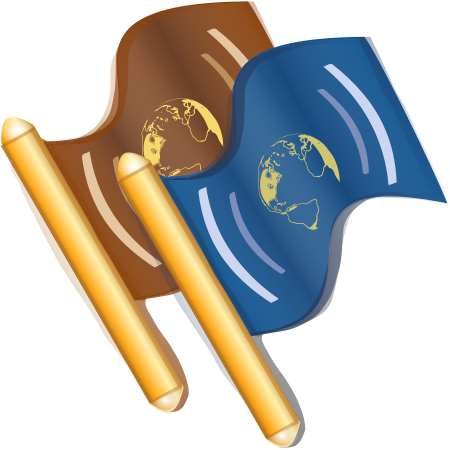
Subdistrik Haidian 海淀街道SubdistrikNegaraRepublik Rakyat TiongkokMunisipalitasBeijingDistrikDistrik HaidianDivisi tingkat desa33 komunitas perumahanZona waktuUTC+8 (Waktu Standar Tiongkok)Kode pos100080 Subdistrik Haidian (Hanzi: 海淀街道; Pinyin: Hǎidiàn jiēdào) merupakan pusat administrasi Distrik Haidian, Beijing, Tiongkok dan saat ini mengelola 33 komunitas perumahan yang berada di bawah yurisdiksinya.[1] Referensi ^ Templat:PRC admin/ref sgc Artikel diterjemahk…

British political party For the Climate party in New Zealand, see NZ Climate Party. Climate Party LeaderEdmund GemmellTreasurerAndy Hill[1]Founded5 September 2022 (2022-09-05)IdeologyGreen conservatismPolitical positionCentre-rightColours Teal BlueHouse of Commons0 / 650 Local government1 / 19,481Websitehttps://theclimate.party/Politics of United KingdomPolitical partiesElections The Climate Party is a minor green conservative political party in the United…
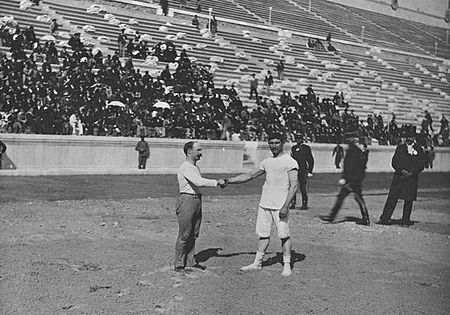
German athlete (1869–1946) Carl SchuhmannSchuhmann at 1896 Summer OlympicsPersonal informationCountry represented GermanyBorn(1869-05-12)12 May 1869Münster, Westphalia, Kingdom of PrussiaDied24 March 1946(1946-03-24) (aged 76)Charlottenburg, Berlin, Allied-occupied GermanyDisciplineMen's artistic gymnastics Medal record Representing Germany Olympic Games Men's artistic gymnastics 1896 Athens Team parallel bars 1896 Athens Team horizontal bar 1896 Athens Vault Men's wrestl…

Artikel ini sebatang kara, artinya tidak ada artikel lain yang memiliki pranala balik ke halaman ini.Bantulah menambah pranala ke artikel ini dari artikel yang berhubungan atau coba peralatan pencari pranala.Tag ini diberikan pada Januari 2023. Kasus SMP Negeri 56 Melawai adalah permasalahan penggunaan lahan yang pernah menimpa SMP Negeri 56 Jakarta pada tahun 2000-an. Sekolah tersebut didirikan pada tahun 1966 dan semula berada di Jalan Melawai Raya, Melawai, Kebayoran Baru, Jakarta Selatan. Na…

United States drug-regulating law Controlled SubstancesLong titleAn Act to amend the Public Health Service Act and other laws to provide increased research into, and prevention of, drug abuse and drug dependence; to provide for treatment and rehabilitation of drug abusers and drug dependent persons; and to strengthen existing law enforcement authority in the field of drug abuse.Acronyms (colloquial)CSAEnacted bythe 91st United States CongressEffectiveMay 1, 1971CitationsPublic law91-513Stat…

Novel by Aaron S. Rosenberg This article does not cite any sources. Please help improve this article by adding citations to reliable sources. Unsourced material may be challenged and removed.Find sources: World of Warcraft: Tides of Darkness – news · newspapers · books · scholar · JSTOR (May 2010) (Learn how and when to remove this message) Tides of Darkness First edition coverAuthorAaron S. RosenbergCover artistGlenn RaneCountryUnited StatesLanguage…

Kerajaan Arab Saudi لَا إِلٰهَ إِلَّا اللَّٰه مُحَمَّدٌ رَسُولُ اللَّٰه(Tiada tuhan selain Allah; Muhammad adalah utusan Allah) Pemakaian Bendera negara dan perang; bendera kapal negara dan perang Perbandingan 2:3 Dipakai 1744; 279 tahun lalu (1744) (versi pertama, pada pendirian Negara Saudi Pertama, hal itu berlanjut ke versi kedua dan awal versi ketiga)11 Maret 1937; 87 tahun lalu (1937-03-11) (versi saat ini, sebagaimana didefinisikan ol…

Private school in Mexico City, Mexico Colegio Amado Nervo is a private school with two campuses in Colonia Roma Sur, Cuauhtémoc, Mexico City. One campus is dedicated to preschool and primary school while the other is dedicated to middle school (escuela secundaria) and high school (escuela preparatoria).[1] References ^ Contacto Archived 2016-04-01 at the Wayback Machine. Colegio Amado Nervo. Retrieved on April 15, 2016. Jardín de Niños y Primaria Bajío no. 315 Colonia Roma Sur Méxic…

مملكة إسرائيل مملكة إسرائيل (أزرق) ومملكة يهوذا (برتقالي) في العصر الحديدي، والبلاد المجاورة لها (القرن الثامن قبل العصر المسيحي) الأرض والسكان إحداثيات 32°16′34″N 35°11′42″E / 32.276111111111°N 35.195°E / 32.276111111111; 35.195 عاصمة شكيمالسامرةترصة/تل الفارعة/ الحفرية اللغة الر�…

County in Wales For the historic county, see Flintshire (historic). For the racehorse, see Flintshire (horse). This article's lead section contains information that is not included elsewhere in the article. If the information is appropriate for the lead of the article, this information should also be included in the body of the article. (October 2023) (Learn how and when to remove this message) County in WalesFlintshire Sir y Fflint (Welsh)CountyLeft to right:Clwydian Range from Waen y Llyn…


